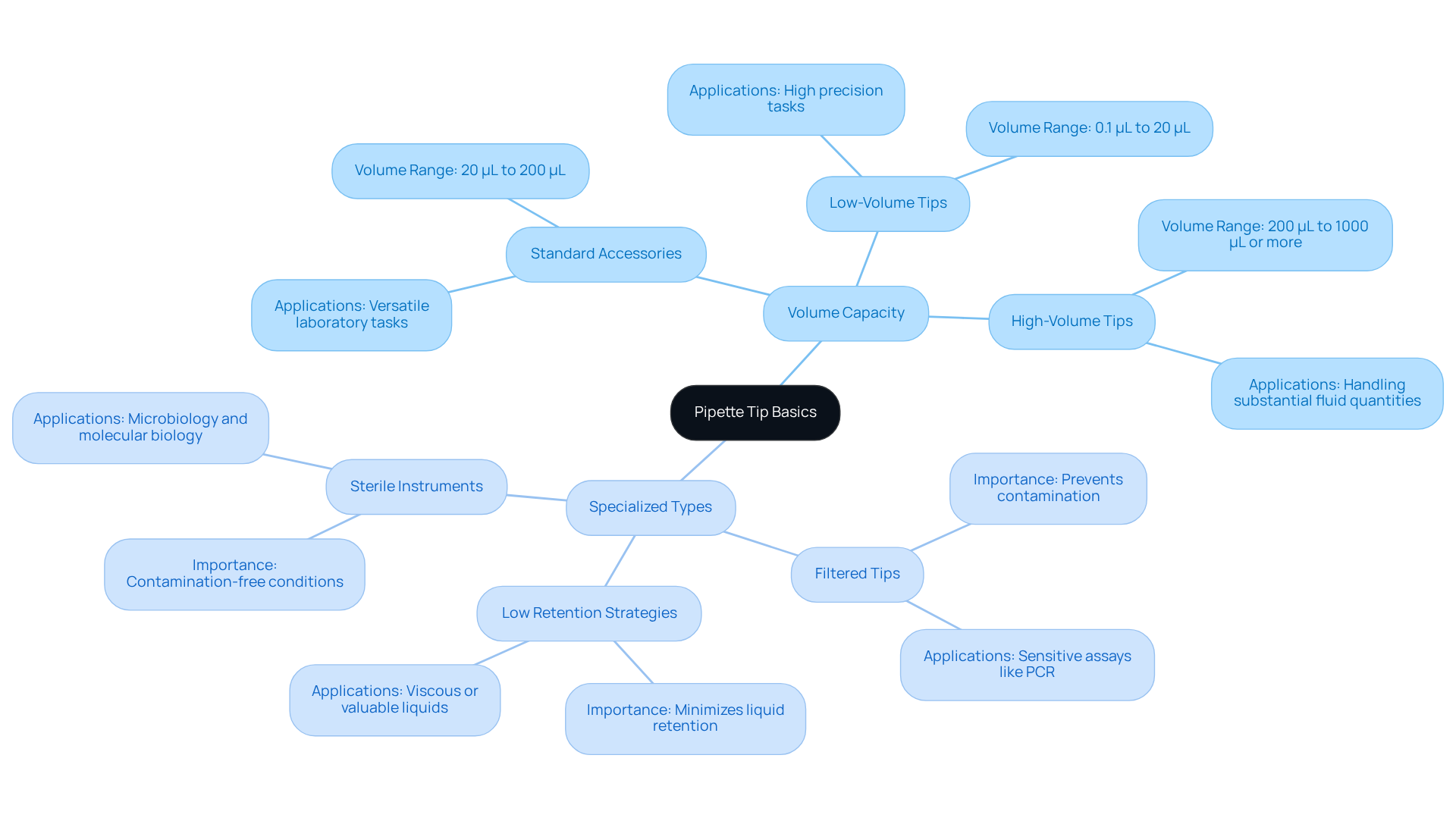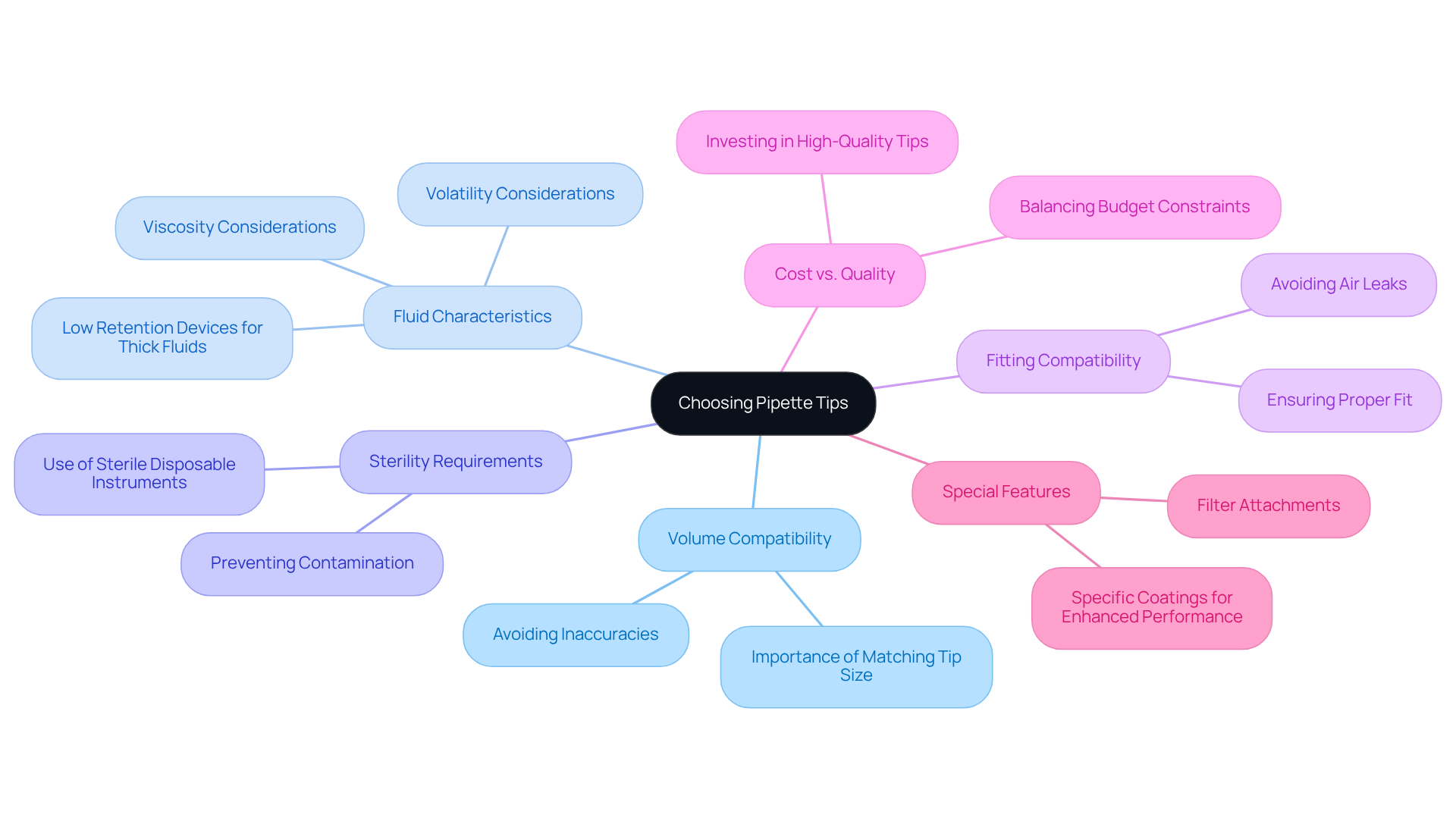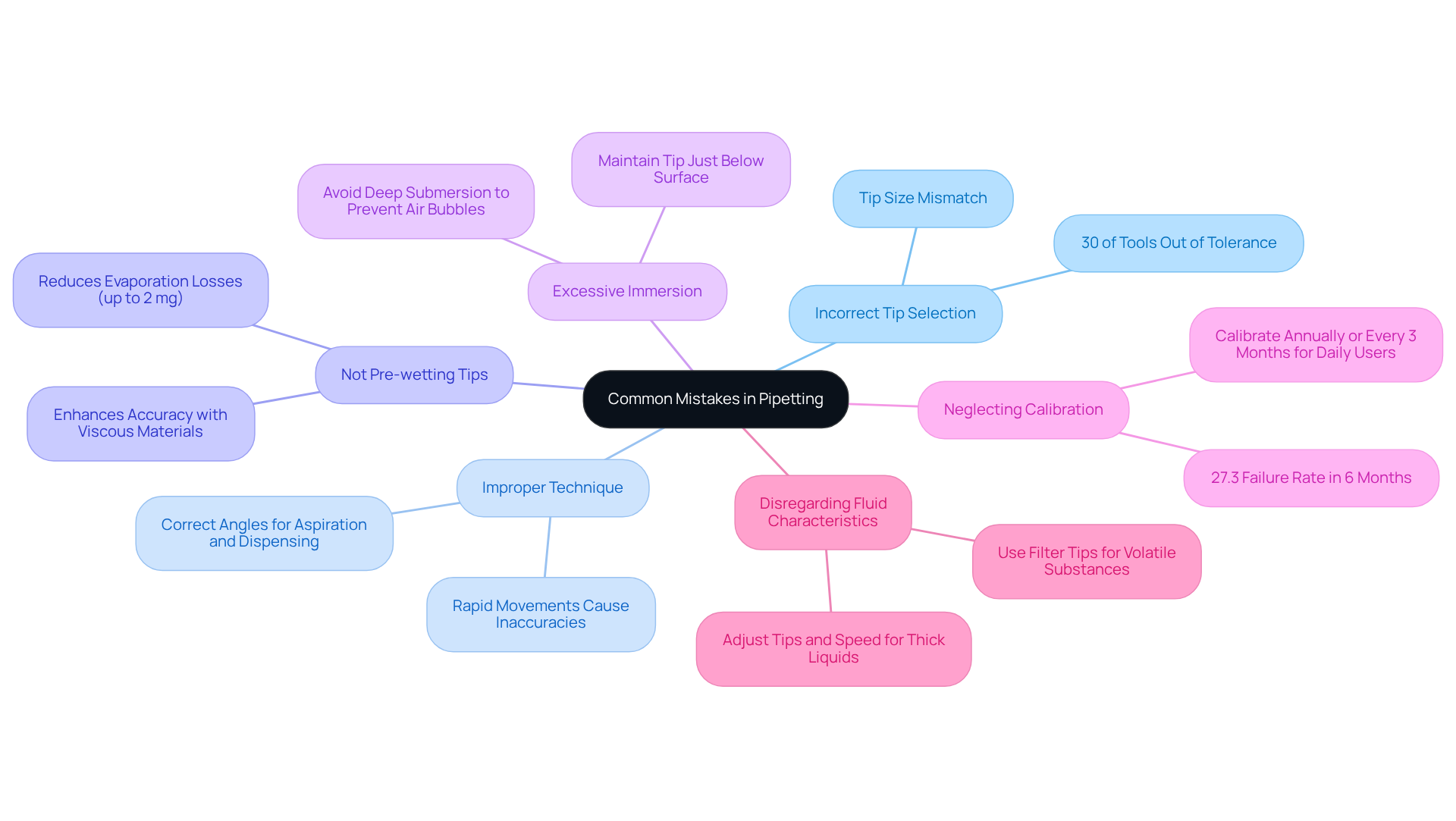Overview
This article emphasizes the critical importance of mastering pipette tip sizes to ensure accurate laboratory results. Selecting the correct tip size is essential for precise liquid transfer; improper tip selection can lead to significant inaccuracies. Evidence supports this, indicating that approximately 30% of liquid handling tools may not operate within expected tolerances. Understanding and implementing the right pipette tips can greatly enhance the reliability of experimental outcomes, ultimately reinforcing the need for high-quality scientific instruments in laboratory settings.
Introduction
Pipetting stands as a fundamental skill in laboratory work; however, many professionals underestimate the critical importance of pipette tip sizes in achieving accurate results. With a variety of tip types designed for specific volume capacities and applications, understanding how to select the appropriate tip can significantly enhance precision in experiments.
What, then, occurs when the wrong tip is chosen, or common pipetting mistakes are made? This guide explores the intricacies of pipette tips, offering insights into mastering their use for optimal laboratory performance.
Understand Pipette Tip Basics
Pipette attachments are indispensable tools for micropipettes, meticulously engineered to ensure precise liquid transfer in scientific settings. They are categorized by volume capacity, a critical factor in achieving reliable results:
- Low-Volume Tips: Perfect for transferring volumes from 0.1 µL to 20 µL, these tips are essential for applications demanding high precision.
- Standard Accessories: Widely utilized for volumes ranging from 20 µL to 200 µL, standard accessories feature various pipette tip sizes that offer versatility across different laboratory tasks.
- High-Volume Pipette Tip Sizes: These pipette tip sizes are designed for larger capacities, typically between 200 µL to 1000 µL or more, facilitating the handling of substantial fluid quantities.
Each type of tip is specifically crafted to fit different models of the instrument, ensuring a secure connection that minimizes air leaks and errors. Selecting the appropriate pipette tip sizes is crucial, as using an incorrect size can lead to significant inaccuracies in fluid handling.
Pipette tips can also be further categorized into specialized types:
- Filtered Tips: These tips feature a barrier that prevents contamination of both the pipette and the samples, making them vital for sensitive applications.
- Low Retention Strategies: Designed to minimize liquid retention, these strategies ensure optimal delivery of viscous or valuable liquids, particularly important in high-stakes experiments.
- Sterile Instruments: Essential in environments that require contamination-free conditions, such as microbiology and molecular biology, these instruments are critical for maintaining sample integrity.
Understanding these categories, especially the different pipette tip sizes and their applications, is vital for professionals aiming to in their work. Research indicates that approximately 70% of testing facilities utilize a combination of pipette tip sizes, which includes low-volume, standard, and high-volume tips, underscoring their importance in achieving precise results. As one lab expert aptly stated, 'The appropriate tip can significantly impact the precision of our outcomes.' By familiarizing yourself with these options, you will be empowered to make informed decisions in your laboratory practices.

Evaluate Key Factors for Choosing Pipette Tips
When selecting , several key factors must be evaluated to ensure optimal performance.
- Volume Compatibility: It is essential to choose a tip that corresponds with the volume range of your device. Using a tip that is too small for the volume can lead to inaccuracies, ultimately affecting experimental outcomes. The pipette accessories market is projected to expand from $2.28 billion in 2024 to $2.46 billion in 2025, underscoring the growing significance of selecting appropriate pipette accessories.
- Fluid Characteristics: The viscosity and volatility of the substance being pipetted are critical considerations. For thick fluids, low retention devices may be necessary to guarantee full transfer. Specific liquid characteristics can greatly influence the selection of sampling devices, as denser liquids require tools designed to minimize sample loss.
- Sterility Requirements: In sterile settings, it is imperative to choose sterile disposable instruments to prevent contamination, which is essential for preserving sample integrity.
- Fitting Compatibility: Ensure that the fittings are compatible with your specific pipette model. A poor fit can result in air leaks and inaccurate measurements, compromising the reliability of your results.
- Cost vs. Quality: While it may be tempting to opt for less expensive alternatives, investing in high-quality suggestions can save time and resources by reducing errors and the need for repeated experiments. Competitive pricing on reliable tools is available, enabling you to prioritize quality without exceeding budget constraints.
- Special Features: Some tips come with additional attributes, such as filters or specific coatings, which can enhance performance in certain applications. For instance, filter attachments are crucial for avoiding contamination during delicate assays, thereby maintaining the integrity of your results.
By thoroughly assessing these factors, laboratory professionals can choose the most suitable pipette tip sizes for their specific requirements, ultimately leading to more precise and dependable outcomes.

Avoid Common Mistakes in Pipetting
To achieve accurate and reliable results in laboratory work, it is crucial to avoid common pipetting mistakes:
- Incorrect tip selection can occur if the pipette tip sizes do not match the volume being handled. Using pipette tip sizes that are either excessively large or small can lead to considerable inaccuracies. Research suggests that as many as 30 percent of liquid handling tools may not operate within anticipated tolerances.
- Improper technique: Consistency in pipetting technique is vital. Hold the device at the correct angle—typically 90 degrees for aspiration and 45 degrees for dispensing—to minimize errors. Rapid movements can interfere with fluid delivery, resulting in inaccuracies.
- Not pre-wetting tips: Pre-wetting the tip by aspirating and dispensing the substance a few times can enhance accuracy, particularly with viscous materials. This practice helps equilibrate air pressure and , which can be as high as 2 mg during pipetting.
- Excessive immersion: Avoid submerging the tip of the device too deeply into the solution, as this can introduce air bubbles and compromise measurement accuracy. Maintaining the tip just below the surface is recommended.
- Neglecting calibration: Regular adjustment of liquid handling devices is essential to ensure proper functionality. An improperly calibrated device can lead to mistakes in fluid management. Research indicates that around 27.3 percent of observed instruments fail during a six-month period. Calibration should occur at least annually, or every three months for daily users.
- Disregarding fluid characteristics: Distinct fluids display unique behaviors. For instance, when transferring volatile substances, utilizing a tip with a filter can prevent contamination of the pipette and guarantee precise delivery. Furthermore, for thick liquids, using low retention devices and adjusting the pipette tip sizes along with pipetting speed can greatly enhance accuracy.
By recognizing these common mistakes and adhering to best practices, laboratory professionals can significantly enhance their pipetting accuracy and reliability, ultimately leading to improved experimental outcomes. Experienced lab technicians emphasize that maintaining optimal volume ranges—typically between 35 to 100 percent of the nominal volume—and using high-quality, compatible pipette tip sizes are essential for consistent volume control and minimizing errors.

Conclusion
Mastering pipette tip sizes is essential for achieving accuracy and reliability in laboratory results. The careful selection of pipette tips, tailored to the specific needs of each experiment, significantly influences the precision of liquid handling. Understanding the various types of tips and their applications empowers laboratory professionals to enhance their experimental outcomes.
Key factors such as volume compatibility, fluid characteristics, sterility requirements, fitting compatibility, and cost considerations play a crucial role in choosing the right pipette tips. Additionally, avoiding common pipetting mistakes—like incorrect tip selection, improper technique, and neglecting calibration—can further improve accuracy. By adhering to best practices, professionals can minimize errors and ensure that their results are both reliable and reproducible.
Ultimately, the significance of mastering pipette tip sizes cannot be overstated. Investing time in understanding these tools and implementing effective pipetting techniques will lead to more accurate laboratory results, reinforcing the critical nature of precision in scientific research. Embracing these practices not only enhances individual performance but also contributes to the overall integrity of scientific inquiry.




